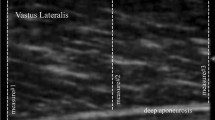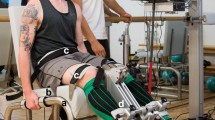Abstract
Purpose
Age-related neuromuscular control adaptations have been investigated mainly in untrained populations, where higher antagonist activation in adults was observed with respect to children. In elite athletes age-related differences in neuromuscular control have scarcely been investigated. Therefore, this study aims at investigating differences in co-activation about the knee joint in two groups of karate athletes belonging to the Junior (JK) and Senior (SK) age categories, performing the roundhouse kick (RK).
Methods
Six SK and six JK performed the RK impacting on a punching bag. Each participant performed three attempts during which kicking limb kinematics and sEMG from the vastus lateralis (VL) and from the biceps femoris (BF) were recorded. Co-activation index during knee flexion and extension (CIF; CIE) and agonist and antagonist activation areas of VL and BF (I AGO-VL; I AGO-BF; I ANT-VL; I ANT-BF) were computed. Hip and knee range of motion, peak angular velocity and minima and maxima of lower limb angular momentum were computed.
Results
During knee extension, the SK demonstrated higher CIE, higher IANT-BF and higher total angular momentum with respect to the JK. Significant relationships were observed between I ANT-BF and total angular momentum maxima, and between I ANT-BF and age.
Conclusions
IANT-BF is partially related to the age of the group and to joint protection upon impact. Moreover, given the very brief duration of the task, a feed-forward mechanism modulating antagonist activation partly based on the stress imposed on the knee joint could be hypothesized. This mechanism potentially involves skill dependent re-modelling of the peripheral and central nervous system.





Similar content being viewed by others
Abbreviations
- A/D:
-
Analogic to digital
- LED:
-
Light emitting diode
- MFCV:
-
Muscle fibre conduction velocity
- RK:
-
Roundhouse kick
- RM-ANOVA:
-
Repeated measure analysis of variance
- sEMG:
-
Surface electromyography
References
Aagaard P, Simonsen EB, Andersen JL, Magnusson SP, Bojsen-Moller F, Dyhre-Poulsen P (2000) Antagonist muscle coactivation during isokinetic knee extension. Scand J Med Sci Sports 10(2):58–67
Assaiante C, Mallau S, Viel S, Jover M, Schmitz C (2005) Development of postural control in healthy children: a functional approach. Neural Plast 12(2–3):109–118 discussion 263–172
Baratta R, Solomonow M, Zhou BH, Letson D, Chuinard R, D’Ambrosia R (1988) Muscular coactivation. The role of the antagonist musculature in maintaining knee stability. Am J Sports Med 16(2):113–122
Basmajian JV (1977) Motor learning and control: a working hypothesis. Arch Phys Med Rehabil 58(1):38–41
Baum BS, Li L (2003) Lower extremity muscle activities during cycling are influenced by load and frequency. J Electromyogr Kinesiol 13(2):181–190
Bautmans I, Vantieghem S, Gorus E, Grazzini YR, Fierens Y, Pool-Goudzwaard A, Mets T (2011) Age-related differences in pre-movement antagonist muscle co-activation and reaction-time performance. Exp Gerontol 46(8):637–642
Bazzucchi I, Felici F, Macaluso A, De Vito G (2004) Differences between young and older women in maximal force, force fluctuations, and surface EMG during isometric knee extension and elbow flexion. Muscle Nerve 30(5):626–635
Bazzucchi I, Sbriccoli P, Marzattinocci G, Felici F (2006) Coactivation of the elbow antagonist muscles is not affected by the speed of movement in isokinetic exercise. Muscle Nerve 33(2):191–199
Camomilla V, Cereatti A, Vannozzi G, Cappozzo A (2006) An optimized protocol for hip joint centre determination using the functional method. J Biomech 39(6):1096–1106
Cappozzo A, Catani F, Croce UD, Leardini A (1995) Position and orientation in space of bones during movement: anatomical frame definition and determination. Clin Biomech (Bristol, Avon) 10(4):171–178
Croce RV, Russel PJ, Schwartz EE, Decoster LC (2004) Knee muscular response strategies differ by developmental level but not gender during jump landing. Electromyogr Clin Neurophysiol 44(6):339–348
de Leva P (1996) Adjustments to Zatsiorsky–Seluyanov’s segment inertia parameters. J Biomech 29:1223–1230
Del Vecchio FB, Franchini E, Del Vecchio AHM, Pieter W (2011) Energy absorbed by electronic body protector in a tae kwon do competition. Biol Sport 28:75–78
Duchateau J, Enoka RM (2008) Neural control of shortening and lengthening contractions: influence of task constraints. J Physiol 586(Pt 24):5853–5864
Estevan I, Alvarez O, Falco C, Molina-Garcia J, Castillo I (2011) Impact force and time analysis influenced by execution distance in a roundhouse kick to the head in taekwondo. J Strength Cond Res 25(10):2851–2856
Falco C, Alvarez O, Castillo I, Estevan I, Martos J, Mugarra F, Iradi A (2009) Influence of the distance in a roundhouse kick’s execution time and impact force in Taekwondo. J Biomech 42(3):242–248
Farina D (2006) Interpretation of the surface electromyogram in dynamic contractions. Exerc Sport Sci Rev 34(3):121–127
Farina D, Ferguson RA, Macaluso A, De Vito G (2007) Correlation of average muscle fiber conduction velocity measured during cycling exercise with myosin heavy chain composition, lactate threshold, and VO2max. J Electromyogr Kinesiol 17(4):393–400
Franz JR, Kram R (2012) How does age affect leg muscle activity/coactivity during uphill and downhill walking? Gait Posture. 10.1016/j.gaitpost.2012.08.004
Frost G, Dowling J, Dyson K, Bar-Or O (1997) Cocontraction in three age groups of children during treadmill locomotion. J Electromyogr Kinesiol 7(3):179–186
Gamage SS, Lasenby J (2002) New least squares solutions for estimating the average centre of rotation and the axis of rotation. J Biomech 35(1):87–93
Grood ES, Suntay WJ (1983) A joint coordinate system for the clinical description of three-dimensional motions: application to the knee. J Biomech Eng 105(2):136–144
Halvorsen K (2003) Bias compensated least squares estimate of the center of rotation. J Biomech 36(7):999–1008
Hamstra-Wright KL, Swanik CB, Sitler MR, Swanik KA, Ferber R, Ridenour M, Huxel KC (2006) Gender comparisons of dynamic restraint and motor skill in children. Clin J Sport Med 16(1):56–62
Hermens HJ, Freriks B, Disselhorst-Klug C, Rau G (2000) Development of recommendations for SEMG sensors and sensor placement procedures. J Electromyogr Kinesiol 10(5):361–374
Hortobagyi T, Devita P (2006) Mechanisms responsible for the age-associated increase in coactivation of antagonist muscles. Exerc Sport Sci Rev 34(1):29–35
Kellis E, Unnithan VB (1999) Co-activation of vastus lateralis and biceps femoris muscles in pubertal children and adults. Eur J Appl Physiol Occup Physiol 79(6):504–511
Kellis E, Arabatzi F, Papadopoulos C (2003) Muscle co-activation around the knee in drop jumping using the co-contraction index. J Electromyogr Kinesiol 13(3):229–238
Kim JW, Kwon MS, Yenuga SS, Kwon YH (2010) The effect of target distance on pivot hip, trunk pelvis and kicking leg in tae kwon do roundhouse kick. Sport Biomech 9(2):98–114
Kim YK, Kim JH, Im SJ (2011) Inter-joint coordination in producing kicking velocity of Tae kwon do kicks. J Sport Sci Med 10:31–38
Koropanovski N, Dopsaj M, Jovanovic S (2008) Characteristic of pointing actions of top male competitors in karate at world and European level. Braz J Biomotr 2:241–251
Lazaridis S, Bassa E, Patikas D, Giakas G, Gollhofer A, Kotzamanidis C (2010) Neuromuscular differences between prepubescents boys and adult men during drop jump. Eur J Appl Physiol 110(1):67–74
Macaluso A, Nimmo MA, Foster JE, Cockburn M, McMillan NC, De Vito G (2002) Contractile muscle volume and agonist-antagonist coactivation account for differences in torque between young and older women. Muscle Nerve 25(6):858–863
Matsushigue KA, Hartmann K, Franchini E (2009) Taekwondo: physiological responses and match analysis. J Strength Cond Res 23(4):1112–1117
Mirwald RL, Baxter-Jones AD, Bailey DA, Beunen GP (2002) An assessment of maturity from anthropometric measurements. Med Sci Sports Exerc 34(4):689–694
Morse CI, Tolfrey K, Thom JM, Vassilopoulos V, Maganaris CN, Narici MV (2008) Gastrocnemius muscle specific force in boys and men. J Appl Physiol 104(2):469–474
Mustard BE, Lee RG (1987) Relationship between EMG patterns and kinematic properties for flexion movements at the human wrist. Exp Brain Res 66:247–256
Nigg BM, Wakeling JM (2001) Impact forces and muscle tuning: a new paradigm. Exerc Sport Sci Rev 29(1):37–41
O’Brien TD, Reeves ND, Baltzopoulos V, Jones DA, Maganaris CN (2009) The effects of agonist and antagonist muscle activation on the knee extension moment-angle relationship in adults and children. Eur J Appl Physiol 106(6):849–856
Petersen TH, Kliim-Due M, Farmer SF, Nielsen JB (2010) Childhood development of common drive to a human leg muscle during ankle dorsiflexion and gait. J Physiol 588(Pt 22):4387–4400
Peterson DS, Martin PE (2010) Effects of age and walking speed on coactivation and cost of walking in healthy adults. Gait Posture 31(3):355–359
Probst MM, Fletcher R, Seelig DS (2007) A comparison of lower-body flexibility, strength, and knee stability between karate athletes and active controls. J Strength Cond Res 21(2):451–455
Quinzi F, Camomilla V, Felici F, Di Mario A, Sbriccoli P (2013) Differences in neuromuscular control between impact and no impact roundhouse kick in athletes of different skill levels. J Electromyogr Kinesiol 23(1):140–150
Quinzi F, Sbriccoli P, Alderson J, Di Mario A, Camomilla V (2014) Intra-limb coordination in karate kicking: effect of impacting or not impacting a target. Hum Mov Sci 33:108–119
Russell PJ, Croce RV, Swartz EE, Decoster LC (2007) Knee-muscle activation during landings: developmental and gender comparisons. Med Sci Sports Exerc 39(1):159–170
Sbriccoli P, Bazzucchi I, Rosponi A, Bernardi M, De Vito G, Felici F (2003) Amplitude and spectral characteristics of biceps Brachii sEMG depend upon speed of isometric force generation. J Electromyogr Kinesiol 13(2):139–147
Sbriccoli P, Sacchetti M, Felici F, Gizzi L, Lenti M, Scotto A, De Vito G (2009) Non-invasive assessment of muscle fiber conduction velocity during an incremental maximal cycling test. J Electromyogr Kinesiol 19(6):e380–e386
Sbriccoli P, Camomilla V, Di Mario A, Quinzi F, Figura F, Felici F (2010) Neuromuscular control adaptations in elite athletes: the case of top level karateka. Eur J Appl Physiol 108(6):1269–1280
Staude GH, Flachenecker C, Daumer M, Wolf W (2001) Onset Detection in Surface Electromyographic Signals: a Systematic Comparison of Methods. EURASIP J Appl Si Pr 2:67–81
Vandervoort AA (2002) Aging of the human neuromuscular system. Muscle Nerve 25(1):17–25
Wakeling JM, Von Tscharner V, Nigg BM, Stergiou P (2001) Muscle activity in the leg is tuned in response to ground reaction forces. J Appl Physiol 91(3):1307–1317
Wu G, Siegler S, Allard P, Kirtley C, Leardini A, Rosenbaum D, Whittle M, D’Lima DD, Cristofolini L, Witte H, Schmid O, Stokes I (2002) ISB recommendation on definitions of joint coordinate system of various joints for the reporting of human joint motion–part I: ankle, hip, and spine. International Society of Biomechanics. J Biomech 35(4):543–548
Conflict of interest
The authors declare that they have no conflict of interest.
Author information
Authors and Affiliations
Corresponding author
Additional information
Communicated by Fausto Baldissera.
Rights and permissions
About this article
Cite this article
Quinzi, F., Camomilla, V., Felici, F. et al. Agonist and antagonist muscle activation in elite athletes: influence of age. Eur J Appl Physiol 115, 47–56 (2015). https://doi.org/10.1007/s00421-014-2990-y
Received:
Accepted:
Published:
Issue Date:
DOI: https://doi.org/10.1007/s00421-014-2990-y




